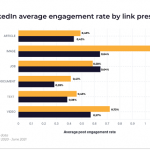By
Contribute to society, improve people’s lives, provide the next groundbreaking solution — these may be our true end goals, but we need our businesses to grow and flourish in order to make these happen.
Enter the seemingly never-ending effort to tone up our websites so they fuel excitement and inspire as many people as possible to connect, purchase or fill out our enticing site form for some free goods.
If you’re anything like me, you’ve heard thousands of ideas that “experts” promise will turn the tide when it comes to converting website leads: more content, less content, delete old blogs, refresh old blogs, add videos, add social proof and the list goes on and on.
I 100% understand the frustration. And as the CEO of a marketing agency, I will also be the first to tell you there is no single strategy that works for every website. But every website does need a strategy.
To uncover what custom strategy will work for your site, in particular, we need to find out why your current site isn’t driving leads. So, let’s dive into five of the most common reasons conversions often fall flat and what you can do about it.
You don’t have any goals.
Every page on your website needs a goal. Whatever the goal is — clicking a product link, watching a video testimonial or just filling out a form — create your page with this in mind.
I have seen hundreds of websites that either had no clear “next step” actions for customers, or worse, too many (confusing) actions from which to choose. Both are more than likely going to eliminate the possibility that your next visitor will convert into a lead.
For example, if you know that a higher number of customers become a valid lead (or buy your product) after watching your product video, then focus on that goal for the page in question. Whatever it is, establish a goal for your page and build everything to support that goal — everything else is fluff.
I know, we all get excited and want to get everything we can think of on the page, but start with your goals and work backward.
Visitors have no idea what you do.
Does your website say what you do, loud and proud, in the most basic terms? All too often, I see businesses that are so laser-focused on sounding different that the core of what they do falls by the wayside.
For example: “We drive business intelligence solutions for best-in-class e-commerce impact!” Um, what? Are you in marketing, finance, software or something else? As a business, if what you actually do or provide is confusing, chances are leads are not going to scour your site to find out.
From the second a customer lands on your website, they need to know what you do or at least be enticed to scroll down and learn more. So, if you are a service provider, say it. You offer a product? Show it — loud and clear.
Your site speed is just too slow.
As the saying goes in the culinary world, “We eat with our eyes first,” and the same is true for your website. So, if your website is slow to load or slow to interact with, this can (and most likely will) tank the perception of your brand and what it has to offer.
When it comes to almost anything online, we all crave instant gratification. That being said, take the time to ensure anything that’s slowing down your site (i.e., images, videos or even website plugins) is optimized accordingly.
Any milliseconds you can shave off of loading and interaction times increase the likelihood that your next visitor will turn into a viable lead. If you want to see what your load speeds are and how you can optimize, try using Google’s Lighthouse plugin for Chrome.
Prospects don’t trust you.
Trust is something that needs to be earned, and in the online space, you need to earn it fast. But how? In a word: proof.
Making bold claims and using spicy taglines are only going to get customers to the front door. It’s your job to kick it in for them. Can you feature any awards, certifications or endorsements? What about media spots, written reviews or video testimonials? In short, can you crank up the dial and give them some solid social proof?
Don’t get me wrong, case studies and data are great, but even adding a single quote from one of your clients is going to move the trust needle several times over.
Social proof from those outside the walls of your business is the greatest trust-building content you can provide to your site visitors, so don’t be afraid to lay it on thick.
You never asked.
Question: What do you want visitors to do on your website — download your how-to guide? Add your product to their cart? Okay, now a follow-up question: Are you asking them to take that action?
One of the first rules in sales is… ask for the sale!
Not sure what to ask? Well, what was the goal you created for this page? This should be directly tied into your “ask.” If your goal is to get the visitor to fill out your form in exchange for your free strategy guide, ask for this on your page.
“Ready to see how to leverage your business intelligence for 5X better ROI? Complete this form for instant access.” Never assume anything, and be willing to ask for what you want.
As with everything “lead gen,” it comes down to putting yourself in the shoes of your customers. Focus on giving them what they want rather than what you think they need. Be ready to test, evaluate and adapt to these wants on a regular basis.
Feature Image Credit: Getty
By
Bernard May is the CEO of National Positions, a 5-time Inc. 500 company, award-winning marketing agency and Google Premier Partner. Read Bernard May’s full executive profile here.
Follow me on Twitter or LinkedIn. Check out my website.





